|
|
|
Sort Order |
|
|
|
Items / Page
|
|
|
|
|
|
|
| Srl | Item |
| 1 |
ID:
127283


|
|
|
|
|
| Publication |
2014.
|
| Summary/Abstract |
In this article, we use the recently developed nonlinear autoregressive distributed lags (NARDL) model to examine the pass-through of crude oil prices into gasoline and natural gas prices. Our approach allows us to simultaneously test the short- and long-run nonlinearities through positive and negative partial sum decompositions of the predetermined explanatory variables. It also offers the possibility to quantify the respective responses of gasoline and natural gas prices to positive and negative oil price shocks from the asymmetric dynamic multipliers. The obtained results indicate that oil prices affect gasoline prices and natural gas prices in an asymmetric and nonlinear manner, but the price transmission mechanism is not the same. Important policy implications can be learned from the empirical findings.
|
|
|
|
|
|
|
|
|
|
|
|
|
|
|
|
| 2 |
ID:
128045


|
|
|
|
|
| Publication |
2014.
|
| Summary/Abstract |
The 2009 Renewable Energies Directive (RED) has set up ambitious targets concerning biofuel consumption in the European Union by 2020. Nevertheless, budgetary constraints and growing concerns about the environmental integrity of first-generation biofuels have imposed a phasing out of the fiscal instruments to promote them. Focusing on France, this paper combines an exogenous increase in oil prices and tax policies on fossil fuels. The objective is to determine the efficiency of an alternative incentive scheme for biodiesel consumption based on a higher price of the fossil fuel substitute. Policy simulations are implemented through a dynamic computable general equilibrium (CGE) model calibrated on 2009 French data. The results show that the 10% biodiesel mandate set by the RED would not be achieved even if the fixed taxes on diesel reach the same level as those on gasoline. Although integrating the rise in oil prices into the fiscal framework improves the biodiesel penetration rate, it remains below the target. Moreover, we find that the effects of biofuel consumption are limited to the biofuel chain sectors. In other agricultural sectors, the substitution effect of biodiesel with diesel is partially offset by the pricing effect induced by higher energy production costs.
|
|
|
|
|
|
|
|
|
|
|
|
|
|
|
|
| 3 |
ID:
127279
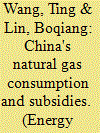

|
|
|
|
|
| Publication |
2014.
|
| Summary/Abstract |
China's natural gas consumption is growing rapidly and it has being driven by economic growth, industrialization and urbanization. In addition, the country's low-carbon development strategy, government-controlled gas price, and some other factors also contribute to the surging gas consumption. This paper studies China's natural gas consumption in residential, industrial and commercial sectors. We adopt the cointegration test and error correction model to study the relationships of explanatory factors and gas consumption of different sectors and climate factor is included into the analysis. In order to find the direction of natural gas pricing reform and establish the benchmark gas price, this paper also estimates the size of gas price subsidy by using price-gap approach. Our findings are as follows: In the long term, China's residential sector is more sensitive to price than the other two. Urbanization is an important factor promoting industrial and commercial gas consumption. Prices of other energies have an influence on natural gas consumption significantly due to the substitutability between energies. The slow-moving and unsatisfying pricing reforms on refined oil and natural gas lead to positive price elasticity of natural gas in the commercial sector, which implies that a further energy price reform is still stringent for China.
|
|
|
|
|
|
|
|
|
|
|
|
|
|
|
|
| 4 |
ID:
127325


|
|
|
|
|
| Publication |
2014.
|
| Summary/Abstract |
After 34 years, the Carter Doctrine remains valid. But there are cheaper and more effective ways of keeping the oil flowing than unilateral deployment of military force.
|
|
|
|
|
|
|
|
|
|
|
|
|
|
|
|
| 5 |
ID:
128099


|
|
|
|
|
| Publication |
2012.
|
| Summary/Abstract |
Followign Tullow Oil's major discovery in Turkana county,Kenya has seen a surge in interest from foreign oil companies. Jeremy Clarke assesses the various security risk facing the country's nascent oil industry and the likely impact on the 2013 election.
|
|
|
|
|
|
|
|
|
|
|
|
|
|
|
|
| 6 |
ID:
127291
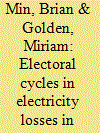

|
|
|
|
|
| Publication |
2014.
|
| Summary/Abstract |
A third of electricity in India is lost each year, where losses refer to power that is supplied but not billed. Utilizing data from the power corporation of Uttar Pradesh, India's most populous state, we study the politics of electricity losses. Examining annual data over four decades, we document that UP's electricity losses tend to increase in periods immediately prior to state assembly elections. Drawing upon geographically disaggregated data for the period 2000-09, we observe higher line losses just prior to the 2002 and 2007 state elections. Our analysis shows that the incumbent party was more likely to retain the assembly seat as line losses in the locality increased. We interpret these results as corroboration that political parties deliberately redirect electricity to flat rate and unbilled users in a context of chronically inadequate supply. Political factors appear to affect line losses in ways that technical and economic factors alone cannot explain.
|
|
|
|
|
|
|
|
|
|
|
|
|
|
|
|
| 7 |
ID:
128000
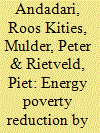

|
|
|
|
|
| Publication |
2014.
|
| Summary/Abstract |
In low- and middle-income countries, Liquefied Petroleum Gas (LPG) can be an attractive alternative to the widespread use of traditional kerosene. Not only is LPG a relatively clean, safe and cost-effective fuel for households, its large-scale adoption also reduces the heavy burden of kerosene consumption subsidies on government budgets. Against this background, we evaluate the impact of a large government program to substitute LPG for kerosene in Indonesia. Using a household survey across urban, suburban and rural regions we find that this program was very effective in causing a large scale shift from kerosene to LPG. This shift was positively influenced by level of education, household size and household income. Contradicting the energy-ladder model, the LPG program, reinforced by an increase in the price of kerosene, led to increased stacking of fuels, including increasing consumption of both electricity and traditional biomass. In addition, our analysis shows that the LPG program failed to substantially reduce the overall number of energy-poor people, but it has been effective in alleviating extreme energy-poverty. Finally, we find that medium and higher income households in suburban areas benefitted most from the LPG program.
|
|
|
|
|
|
|
|
|
|
|
|
|
|
|
|
| 8 |
ID:
127996
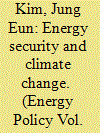

|
|
|
|
|
| Publication |
2014.
|
| Summary/Abstract |
Fast growing global energy needs raise concerns on energy supply security and climate change. Although policies addressing the two issues sometimes benefit one at the expense of the other, technology innovation, especially in alternative energy, provides a win-win solution to tackle both issues. This paper examines the effect of oil endowment on the patterns of technology innovation in the transportation sector, attempting to identify drivers of technology innovation in alternative energy. The analysis employs panel data constructed from patent data on five different types of automobile-related technologies from 1990 to 2002: oil extraction, petroleum refining, fuel cells, electric and hybrid vehicles (EHV) and vehicle energy efficiency. I find that countries with larger oil endowments perform less innovation on refining and alternative technologies. Conversely, higher gasoline prices positively impact the patent counts of alternative technologies and energy efficiency technology. The findings highlight the challenges and importance of policy designs in international climate change agreements.
|
|
|
|
|
|
|
|
|
|
|
|
|
|
|
|
| 9 |
ID:
127280


|
|
Financial analysis on the proposed renewable heat incentive for: a case study on the solar thermal system
/ Bakar, Siti Hawa Abu; Sukki, Firdaus Muhammad; Iniguez, Roberto Ramirez; Munir, Abu Bakar, Yasin, Siti Hajar Mohd, Mallick, Tapas Kumar, McLennan, Campbell, Rahim, Ruzairi Abdul
|

|
|
|
|
| Publication |
2014.
|
| Summary/Abstract |
This short communication paper focuses on the renewable heat incentive (RHI) scheme in the United Kingdom (UK); and in particular, on its implication on domestic installations of solar thermal systems (STSs). First, a short review on the STS in the UK is provided. Then, a detailed description of the RHI is discussed. A financial analysis is presented afterwards, analysing the impact of the RHI scheme on the applicants, in terms of the net present value and the internal rate of return. From the financial analysis it has been found that the RHI scheme for domestic installations is only attractive if a longer period of RHI payment, i.e. 17 years, or a higher RHI rate i.e. £0.32 per kW h is implemented. The current proposal from the UK government is not financially viable, and as a result, it may hinder the penetration of domestic solar thermal systems in the residential sector in the UK.
|
|
|
|
|
|
|
|
|
|
|
|
|
|
|
|
| 10 |
ID:
127273


|
|
|
|
|
| Publication |
2014.
|
| Summary/Abstract |
As government and industry plan to reduce energy consumption in building stock, there is a need to forecast the uptake of retrofit packages across building stock over time. To address this challenge a diffusion model was set up and applied to office building stock across New South Wales (NSW) in Australia, accommodating a high spatial resolution and temporal capability for projecting uptake of technology packages characterised by multiple variables. Six retrofit packages were set up for the diffusion model, which ranged from inexpensive services and manuals through to mid-priced packages involving energy efficient T5 lighting and solar hot water through to expensive packages such as chilled beams and Solar PV. We evaluated the model using a base case and two policy programs, representing the Green Building Fund and Environmental Upgrade Agreements. These were recent incentive programs funded by the Australian government to accelerate the uptake of retrofit packages, by providing financial support to upfront expenditures and removing barriers to retrofit. By forecasting uptake of each retrofit package to 2032 under each program, we demonstrate how the model can be a valuable resource in tailoring expensive government programs and increasing their effectiveness.
|
|
|
|
|
|
|
|
|
|
|
|
|
|
|
|
| 11 |
ID:
127267


|
|
Heat roadmap Europe: combining district heating with heat savings to decarbonise the EU energy system
/ Connolly, D; Lund, H; Mathiesen, B.V; Werner, S, Möller, B, Persson, U, Boermans, T, Trier, D, Ostergaard, PA, Nielsen, S
|

|
|
|
|
| Publication |
2014.
|
| Summary/Abstract |
Six different strategies have recently been proposed for the European Union (EU) energy system in the European Commission's report, Energy Roadmap 2050. The objective for these strategies is to identify how the EU can reach its target of an 80% reduction in annual greenhouse gas emissions in 2050 compared to 1990 levels. None of these scenarios involve the large-scale implementation of district heating, but instead they focus on the electrification of the heating sector (primarily using heat pumps) and/or the large-scale implementation of electricity and heat savings. In this paper, the potential for district heating in the EU between now and 2050 is identified, based on extensive and detailed mapping of the EU heat demand and various supply options. Subsequently, a new 'district heating plus heat savings' scenario is technically and economically assessed from an energy systems perspective. The results indicate that with district heating, the EU energy system will be able to achieve the same reductions in primary energy supply and carbon dioxide emissions as the existing alternatives proposed. However, with district heating these goals can be achieved at a lower cost, with heating and cooling costs reduced by approximately 15%.
|
|
|
|
|
|
|
|
|
|
|
|
|
|
|
|
| 12 |
ID:
127287


|
|
|
|
|
| Publication |
2014.
|
| Summary/Abstract |
It is widely accepted that interventions designed to promote household energy efficiency, like insulation, central heating and double glazing, can help to reduce cold-related illnesses and associated stress by making it easier for residents to keep their homes warm. However, these interventions may also have a detrimental effect on health. For example, the materials used or lower ventilation rates could result in poorer indoor air quality. The present research sought to systematically quantify the impact of household energy efficiency measures on health and wellbeing. Thirty-six studies, involving more than 33,000 participants were meta-analysed. Effect sizes (d) ranged from ?0.43 (a negative impact on health) to 1.41 (a substantial positive impact on health), with an overall sample-weighted average effect size (d+) of 0.08. On average, therefore, household energy efficiency interventions led to a small but significant improvement in the health of residents. The findings are discussed in the context of the health improvements experienced by different groups of participants and the study design factors that influence health outcomes. The need for future studies to investigate the long term health benefits of interventions designed to promote household energy efficiency is identified.
|
|
|
|
|
|
|
|
|
|
|
|
|
|
|
|
| 13 |
ID:
127275
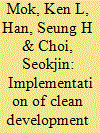

|
|
|
|
|
| Publication |
2014.
|
| Summary/Abstract |
Greenhouse gas emissions due to human activities are the main contributors to global climate change, a problem that should not be ignored. Through the clean development mechanism (CDM) introduced under the Kyoto Protocol, developing countries are able to earn certified emission reduction (CER) credits through a myriad of emission reduction projects. This study aims to explore the potential of implementing CDM projects in the construction and built environment (C&BE) industry, which has been criticized for not only consuming an enormous amount of resources, but also for contributing to adverse environmental health. In this research, we limit the boundary of the C&BE industry to include the planning, procurement, construction, occupation and refurbishment/demolition phases of a project's life cycle. Surveys and in-depth follow-up interviews with experts have generated useful insights pertaining to CDM potential and its adaptation into the C&BE industry. From this foundation, this paper evaluates the current obstacles to CDM and presents feasible suggestions to increase CDM projects related to the C&BE industry.
|
|
|
|
|
|
|
|
|
|
|
|
|
|
|
|
| 14 |
ID:
127269
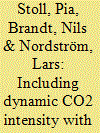

|
|
|
|
|
| Publication |
2014.
|
| Summary/Abstract |
Hourly demand response tariffs with the intention of reducing or shifting loads during peak demand hours are being intensively discussed among policy-makers, researchers and executives of future electricity systems. Demand response rates have still low customer acceptance, apparently because the consumption habits requires stronger incentive to change than any proposed financial incentive. An hourly CO2 intensity signal could give customers an extra environmental motivation to shift or reduce loads during peak hours, as it would enable co-optimisation of electricity consumption costs and carbon emissions reductions. In this study, we calculated the hourly dynamic CO2 signal and applied the calculation to hourly electricity market data in Great Britain, Ontario and Sweden. This provided a novel understanding of the relationships between hourly electricity generation mix composition, electricity price and electricity mix CO2 intensity. Load shifts from high-price hours resulted in carbon emission reductions for electricity generation mixes where price and CO2 intensity were positively correlated. The reduction can be further improved if the shift is optimised using both price and CO2 intensity. The analysis also indicated that an hourly CO2 intensity signal can help avoid carbon emissions increases for mixes with a negative correlation between electricity price and CO2 Intensity.
|
|
|
|
|
|
|
|
|
|
|
|
|
|
|
|
| 15 |
ID:
127282


|
|
|
|
|
| Publication |
2014.
|
| Summary/Abstract |
Plug-In Electric Vehicles (PEVs) provide an opportunity for reducing energy use and emissions in the transportation sector. Currently, a number of federal policies are in place to incentivize deployment of PEVs to mainstream consumers with demographics and vehicle attribute preferences most common to today's new vehicle purchasers. This article argues that policies intending to give PEVs a foothold in the market should not focus on mainstream consumers and should instead focus on niche markets-specifically carsharing and postal fleets-and early adopters including green consumers. Two arguments can be made in support of eliminating the mainstream market bias of current policies toward a policy of cultivating niche markets. The first is efficiency: so far PEV policies featuring a mainstream market bias have proven to be inefficient and costly. The second is effectiveness: it is becoming increasingly evident that PEV policies would be more effective in achieving potential societal benefits if they focused on early adopters and niche markets using such approaches as strategic niche management, accessible loans and financing, and appropriately targeted incentives. PEV policies focused on early adopters and niche markets would create complementary system effects that will lead to increased PEV market penetration and realization of intended societal benefits.
|
|
|
|
|
|
|
|
|
|
|
|
|
|
|
|
| 16 |
ID:
127285


|
|
|
|
|
| Publication |
2014.
|
| Summary/Abstract |
This paper presents a methodology for quantitatively assessing energy security. The methodology is tailored to suit the limited data availability of Malaysia and other Southeast Asian countries. In this methodology, energy security is conceptualized as having 5 core aspects which sub-divide into 13 elements. A total of 35 indicators have been identified as measurements of these 13 elements. The methodology details the means by which the indicator results are converted into a common unit i.e. a normalization process into a 0-to-1 scale. Also detailed are the weights used in the weighted-average process by which normalized indicators are synthesized into composite scores representing the 13 elements, the 5 core aspects, and 1 overall energy security index.
|
|
|
|
|
|
|
|
|
|
|
|
|
|
|
|
| 17 |
ID:
127289


|
|
|
|
|
| Publication |
2014.
|
| Summary/Abstract |
Better methods of characterizing and addressing heterogeneity in preferences and decision making are needed to stimulate reductions in household greenhouse gas emissions. Four residential energy efficiency programs were delivered consecutively in the Region of Waterloo, Canada, between 1999 and 2011, and each offered a unique combination of information, financial reward structure, and price. A natural quasi-experimental intervention design was employed to assess differences in outcomes across these program structures. Participation at the initial (evaluation by an energy advisor) and follow-up (verification of retrofit) stages, and the material characteristics (e.g., energy performance) were measured and compared between the groups of houses included in each program at each stage. The programs appealed to people with different types of material concerns; each phase of the program was associated with houses with a different mix of material characteristics and depths of recommended and achieved changes. While a performance-based reward attracted fewer houses at each stage than a larger list-based reward, older houses with poorer energy performance were included at each stage. The findings support experimentation with program designs to target sub-populations of housing stock; future program designs should experiment more carefully and with larger performance-based rewards and test parallels with potential carbon market structures.
|
|
|
|
|
|
|
|
|
|
|
|
|
|
|
|
| 18 |
ID:
127290


|
|
|
|
|
| Publication |
2014.
|
| Summary/Abstract |
Price volatility in green certificate markets reflects uncertainty over future prices, representing a major source of risk for renewable energy generators. Price risk is considered the principal deficiency of this market-based policy since it causes investors to require higher returns. Moreover, investors are exposed to regulatory risk; namely, the risk that a change in the regulation will materially impact the certificate price. Regulatory uncertainty is reflected in market volatility exacerbating certificate price risk. Using an econometric approach, we investigate the role of regulatory changes on price volatility in the Swedish certificate market. The results of our analysis indicate that regulatory changes strongly affect certificate markets, resulting in periods of higher volatility. Moreover, we analyze whether certificate price volatility has changed after creating a joint Swedish/Norwegian market. Results indicate that the ambivalence surrounding the creation of this bigger market led to a period of increased price volatility between 2010 and 2011. Overall, this article brings a better understanding of the role of regulatory uncertainty on certificate markets, and gives evidence for its negative impact in terms of increased price volatility.
|
|
|
|
|
|
|
|
|
|
|
|
|
|
|
|
| 19 |
ID:
127277


|
|
|
|
|
| Publication |
2014.
|
| Summary/Abstract |
Why do people sometimes refrain from saving energy even if it would pay off in monetary terms? Subjective discount rates present one possible explanation for this lack of foresight, but little is known about their level and reliability in the general population. With regard to behavior, persons with lower discount rates are expected to accept additional costs upfront more readily than those with higher discount rates. Based on a representative nation-wide study, the Swiss Environmental Survey 2007, and a follow-up survey, our analyses reveal that on average subjective discount rates are well above market interest rates and moderately stable over a time interval of four years. Income and education are negatively correlated with discount rates. Contrary to expectations, we did not find convincing support for an impact of discount rates on energy saving behavior.
|
|
|
|
|
|
|
|
|
|
|
|
|
|
|
|
| 20 |
ID:
127264


|
|
|
|
|
| Publication |
2014.
|
| Summary/Abstract |
The last decade has seen an increase in the importance of energy efficiency and the sustainable use of energy resources due to their significant benefits for reducing a country's dependence on foreign energy resources and increasing awareness on environmental problems. Turkey aims to reduce its energy intensity by 20% up to 2023, and in order to accomplish this target, the country plans to use energy more effectively in various industries and develop financial mechanisms for energy efficiency. Although much effort has been made to improve energy efficiency, additional policies such as marked-based incentives are still necessary. This article deals with one of the many market-based energy efficiency policies, called Tradable White Certificates (WhC) or Energy Efficiency Obligations. The current situation of the energy field in Turkey and energy consumption by industries is presented first in this paper, followed by potentials for energy efficiency in each industry and energy efficiency policies. Furthermore, the theory and applicability of a WhC System is introduced and discussed in terms of market conditions, choice of obligated participants and market mechanisms and barriers for the Turkish electricity and natural gas market to benefit from the residential and industrial energy savings potential.
|
|
|
|
|
|
|
|
|
|
|
|
|
|
|
|
|
|
|
|
|